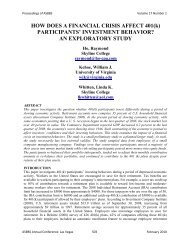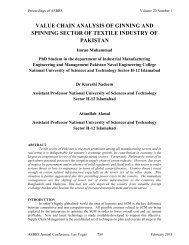stock repurchase announcements: a test of market ... - Asbbs.org
stock repurchase announcements: a test of market ... - Asbbs.org
stock repurchase announcements: a test of market ... - Asbbs.org
Create successful ePaper yourself
Turn your PDF publications into a flip-book with our unique Google optimized e-Paper software.
e unique and known only by the individual it has been issued to, but once a criminal has access<br />
to that information, then the thief can virtually become that individual.<br />
Information on a driver’s license alone is usually enough for identity thieves to commit numerous<br />
acts <strong>of</strong> fr aud. The infor mation on a driver’ s license consists <strong>of</strong> the na me, address, date <strong>of</strong> birth,<br />
and license num ber <strong>of</strong> the individual it identifies. The driver’s license is pre ferred by criminals<br />
because it is the form <strong>of</strong> identification that contai ns an image <strong>of</strong> th e owner, according to Berghel<br />
(2006). Whe n a license h as been obtai ned, criminals only need t o replace the picture with their<br />
own to make the license appear credible. Cri minals also cr eate counterfeit licenses with either<br />
actual or fictitious information for the same purpose.<br />
Victims who knew how th eir information was stolen claim the identity thieves used si mple and<br />
common methods. These techniques include: lost or stolen wallets, mail intercepts, and thef t by<br />
individuals who had a relationship with the victi m (Cheney, 2003). At one time cri minals were<br />
even able to obtain information neede d to co mmit identity theft by purchasing an individual’s<br />
driving record from the Department <strong>of</strong> Motor Vehicles. However, this changed with the Driver’s<br />
Privacy Protection Act <strong>of</strong> 1994, which limited access to m otor vehicle records. We are now in<br />
the Information Age, where criminals have all the information needed to commit identit y right at<br />
their fingertips, courtesy <strong>of</strong> the Internet.<br />
The Internet has opened new avenue s for criminals that have made it easier to obtain personal<br />
information needed to commit identity theft. Online transactions have risen over the past dec ade,<br />
increasing the am ount <strong>of</strong> inform ation available to thieves. In 2002, the U.S. Depart ment <strong>of</strong><br />
Commerce claimed that In ternet sales grew at a r ate <strong>of</strong> 25 percent (Cheney , 2003). This means<br />
that more consumers are using the Internet to purchase items, leaving a trail for identity thieves to<br />
follow. Consu mers need to be aware that Intern et transactions pose threat s to their inf ormation<br />
due to computer hackers, cookies, and other forms <strong>of</strong> online theft (Milne, 2004).<br />
Consumers who do busine ss online become vulnera ble to identity theft because inform ation on<br />
their personal computer, as well as their business computer, may be accessed by criminals (Milne,<br />
2004). The reason for this vulnerabilit y can be attributed to the fact that while online, a<br />
consumer’s inform ation, if not properl y protected, is susceptible to theft. Consum ers provide<br />
credit card numbers and other personal inform ation when completing online transactions that can<br />
be easily intercepted or com promised due to l ackadaisical co mputer security . An easy way to<br />
improve security is to install a firewall and remove spyware frequently, as well as installing virus<br />
protection.<br />
Identification information is also at risk afte r an online transaction occu rs. Com pany’s records<br />
now contain customer information, where their own com puter sy stem is a t risk for theft.<br />
According to White (2005), “Intruders attack a typical US firm ’s co mputer security numerous<br />
times in a week” (p. 850) . A business’ s computers are just as susceptible to identit y theft as a<br />
personal computer, but they are required to have immense security measures in place to safeguard<br />
their custo mer’s personal identity information. Ho wever, data t heft by em ployees and thieves<br />
hacking into company databases, are more serious threats for identity theft to c ustomers (Milne,<br />
2004).<br />
Another concern with online transactions is th e lack <strong>of</strong> face-to-face co mmunication between the<br />
two parties involved . Th e supplier is placing c onfidence in the indivi dual purchasing goods <strong>of</strong>f<br />
the Internet. This raises the dilemma <strong>of</strong> custom er authentica tion. Wit hout the face-to- face<br />
contact, customer authentication becomes virtua lly unreliable. The absenc e <strong>of</strong> face-to- face<br />
communication gives identity thieves an open door to pose as another indivi dual. Simply stated,<br />
ASBBS E-Journal, Volume 4, No.1, 2008 48<br />
ID Theft

















